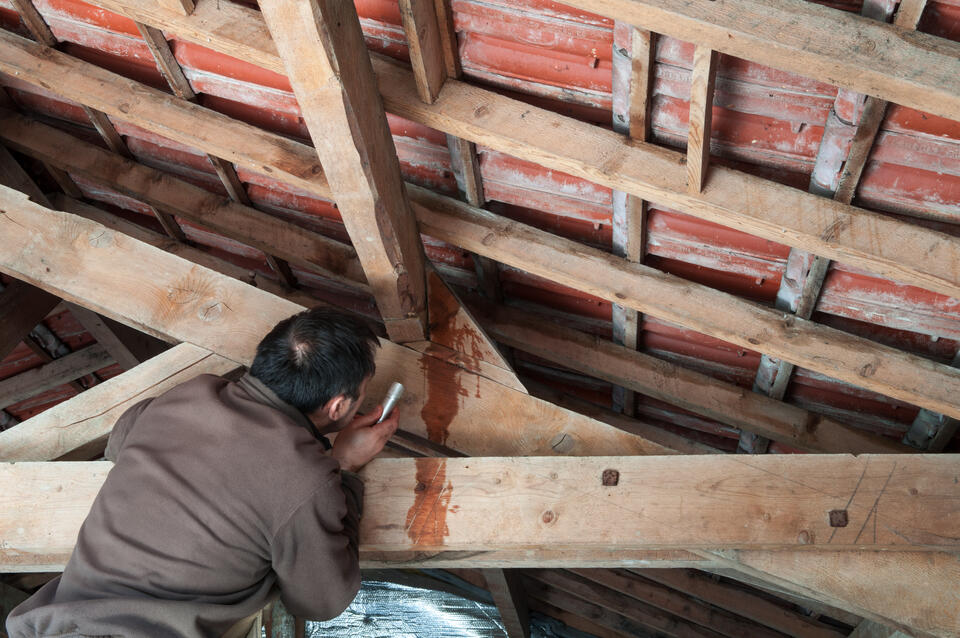A leak in your tile roof can quickly go from a minor annoyance to a major headache if left unaddressed. Whether you’re dealing with water stains on your ceiling or an unwelcome drip during a storm, understanding the cause of your tile roof leak is crucial. This blog will cover everything you need to know, including:
- Problem areas to inspect
- Common causes for a tile roof leaking
- How to address and avoid roof leaks in the future
💧 Understanding the Dangers of a Leaking Tile Roof

A leaking tile roof isn’t just an inconvenience; it can lead to significant issues if not addressed promptly. Ignoring even a small leak can pave the way for more extensive damage to your home’s structure and interiors. Here are some of the potential dangers of a leaking tile roof:
- Water Damage to the Interior: Persistent leaks can ruin ceilings, walls, and flooring, causing unsightly stains and weakening structural materials over time.
- Mold and Mildew Growth: Moisture from a leak creates the perfect environment for mold and mildew, which can lead to health issues for you and your family.
- Compromised Insulation: Water intrusion can damage insulation, reducing its effectiveness and driving up your energy bills.
- Weakened Roof Structure: Prolonged exposure to water can cause wooden beams and other structural components to rot, leading to costly repairs or even potential safety hazards.
- Electrical Hazards: A leak that reaches electrical systems poses a significant shock or fire risk if water comes into contact with wiring or outlets.
Understanding these risks highlights why addressing tile roof leaks quickly is essential to protecting your home and ensuring the safety of everyone inside.
🔎 Problem Areas to Inspect on a Leaking Tile Roof
Not sure where to start when inspecting your tile roof for damage? Here’s a detailed guide to help you focus on the most common areas where leaks or weaknesses can occur.
The Tiles Themselves
The most obvious place to start is with the tiles themselves. Take a close look for visible cracks, chips, or any tiles that appear loose or out of alignment. Missing tiles are another major issue to watch for, as they leave your roof exposed to the elements. Even small cracks can allow water to seep through, so be thorough in your inspection. Keep in mind that damage might not be isolated to one area—scan the entire roof for any signs of wear and tear.
The Roof Valleys
Roof valleys, where two slopes meet, are designed to direct water down to the gutters. However, these areas handle a high volume of water, making them more vulnerable to leaks. Inspect the valleys for debris buildup, as this can cause water to pool instead of draining properly. Also, check for any signs of damage or deterioration in the materials used to seal and protect these areas, as compromised valleys can lead to significant water infiltration.
Around Chimneys, Skylights, and Vents
Chimneys, skylights, and vents are common culprits for roof leaks due to the gaps and seams required to accommodate them. Examine the flashing around these areas for any looseness, cracks, or corrosion. Water may also pool near these fixtures if they’re not properly sealed, so make sure to check for discoloration or dampness on the surrounding tiles. Pay extra attention to how water is draining around these elements—poor drainage can quickly lead to leaks.
The Underlayment
The underlayment is a critical waterproof barrier underneath your tiles, and it can deteriorate over time. If you can safely access it, inspect the underlayment for signs of wear, such as tears, holes, or fraying edges. Discoloration or a damp texture may indicate that water has already penetrated this layer. Since the underlayment is your roof’s last line of defense, any damage here should be addressed immediately to prevent further issues.
The Gutters
Your gutters play an essential role in directing water away from your roof and home. Clogged or damaged gutters can lead to water backing up, which may cause leaks in your tile roof. Check for leaves, twigs, and other debris, and ensure the gutters are securely attached and not sagging. After a heavy rain, confirm that water is flowing properly through the gutters and downspouts. Poor gutter maintenance can put unnecessary pressure on your roof and lead to preventable leaks.
👉 7 Common Causes of a Tile Roof Leaking

Tile roofs are known for their durability, longevity, and visual appeal, but they aren’t completely invincible. Over time, various issues can arise that lead to leaks. Here’s a detailed look at some of the most common causes of tile roof leaks and what you can do about them.
1. Cracked or Broken Tiles
Tiles are designed to withstand harsh weather conditions, but they aren’t indestructible. Severe storms, hail, or fallen branches can crack or shatter tiles, leaving gaps for water to seep through. Even small cracks that may go unnoticed can result in significant water intrusion over time. Additionally, general wear and tear, such as exposure to UV rays and temperature fluctuations, can weaken tiles, making them more prone to damage. Regular inspections and prompt replacement of damaged tiles can prevent these minor issues from escalating into costly repairs.
2. Degraded Underlayment
The underlayment is a critical component beneath your tiles, acting as a waterproof barrier to protect your home from leaks. Over time, this layer can degrade due to prolonged exposure to moisture, heat, and debris. Once the underlayment begins to fail, water has a clear path to penetrate your roof structure and enter your home’s interior. Signs of underlayment failure include water stains on ceilings, sagging in the roof, or mold growth. Replacing the underlayment is often necessary to restore the roof’s integrity and prevent further damage. Regular maintenance can extend the life of your underlayment.
3. Poor Installation
A tile roof is only as good as its installation. If the tiles are misaligned, inadequately sealed, or improperly secured, weak points can form where water can easily enter. For example, exposed or uneven underlayment, poorly fitted flashing, or tiles that don’t overlap correctly can compromise the roof’s effectiveness. Poor installation often results in leaks appearing soon after the roof is installed, especially during heavy rain. To avoid these issues, always hire experienced and reputable roofing contractors who specialize in tile roofs and follow industry best practices.
4. Missing Tiles
Strong winds, severe storms, or improper installation can cause tiles to become loose or dislodged, leaving exposed areas on your roof. Missing tiles create an open pathway for rainwater to reach the underlayment and roof decking, leading to leaks. This type of damage is especially problematic in regions prone to high winds or extreme weather conditions. Regular roof inspections, especially after storms, can help you spot and replace missing tiles before they cause significant damage.
5. Faulty Flashing
Flashing is the material used to seal the joints and seams around chimneys, vents, skylights, and other roof penetrations. If the flashing is damaged, corroded, or installed incorrectly, water can enter through these weak points. Over time, flashing can warp, crack, or separate from the surface it’s meant to protect, often due to weather exposure or shifting roof materials. Faulty flashing is a common cause of roof leaks, and addressing it may require resealing, repairs, or replacement. Proper installation and routine inspections can ensure the flashing remains effective in keeping water out.
6. Clogged Gutters
Although gutters are not part of your roof itself, they play a vital role in directing water away from your home. When gutters become clogged with leaves, debris, or dirt, water can back up and collect under the edge of your roof tiles. This pooling water can seep into the underlying roof layers, causing leaks and potential structural damage. Cleaning your gutters regularly, especially after heavy storms or during the fall, can prevent blockages and protect your roof from water damage. Consider installing gutter guards to reduce buildup and make maintenance easier.
7. Natural Wear and Tear
Even the most well-built tile roof will experience wear and tear as it ages. Decades of exposure to sunlight, rain, wind, and temperature fluctuations gradually weaken the materials, making them more susceptible to cracks, breaks, and leaks. Over time, the cumulative effects of weathering can compromise the underlayment, flashing, and tiles themselves. If your roof is nearing the end of its lifespan (typically 50-100 years for clay or concrete tiles), it may be time to consider a comprehensive roof replacement to ensure continued protection. Regular maintenance and timely repairs can help extend your roof’s life, but eventually, natural aging will take its toll.
💡 How to Address and Avoid Tile Roof Leaks

Tile roof leaks can lead to costly water damage and structural issues if not addressed promptly. Learning how to prevent and fix these leaks helps protect your home and extend the life of your roof.
Repairing a Tile Roof Leak
Repairing a tile roof leak often begins with replacing broken or missing tiles. This is usually the most visible sign of a leak and is relatively straightforward to address. Fixing damaged tiles should always be the first step in resolving the issue.
Next, check the flashing. If the flashing is loose, cracked, or otherwise ineffective, it’s important to replace or reseal it to prevent further water intrusion. Flashing plays a crucial role in keeping your roof watertight.
Finally, inspect the underlayment. If the underlayment is damaged, it may be the root cause of the leak. In this case, you’ll need to hire a professional roofer to remove the affected materials and replace them to restore your roof’s integrity.
Long-Term Prevention Tips
- Regular Roof Inspections: Schedule professional inspections at least once a year to identify and address small problems before they turn into bigger issues.
- Clean the Gutters: Keep your gutters clean to prevent water pooling near the edges of your roof.
- Proactive Repairs: Don’t ignore minor issues like a single cracked tile or a small leak; resolving them quickly saves money and prevents further damage.
- Choose Experienced Roofers: If you’re replacing your roof or undertaking significant repairs, select a trusted professional who specializes in tile roofs to ensure high-quality installation.
Preventing leaks requires regular maintenance and prompt action when problems arise. But when in doubt, lean on experts who can make your roof as good as new.
🙌 Expert Tile Roof Care You Can Trust
At Monarch Roofing, we pride ourselves on delivering exceptional service backed by years of experience and expertise in tile roof care. Our team is dedicated to providing thorough inspections, precise repairs, and high-quality installations to protect your home and give you peace of mind. With a reputation built on trust and satisfied customers, we treat your roof as if it were our own. Don’t wait for small issues to turn into costly problems—reach out to Monarch Roofing today for all your tile roof needs. Contact us now for a free consultation and see why homeowners rely on us for dependable roofing solutions!





